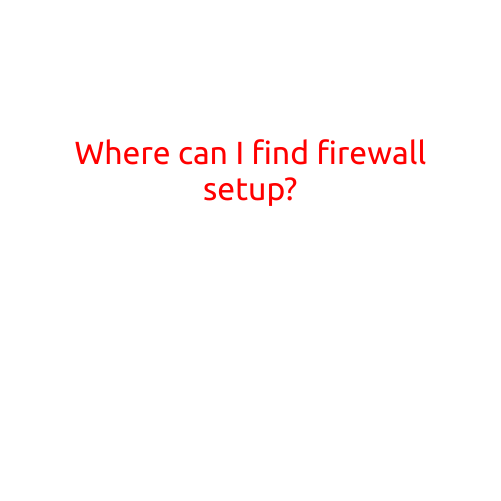
Where Can I Find Firewall Setup?
As the first line of defense against cyber threats, firewalls play a critical role in protecting your devices, networks, and data from unauthorized access. Setting up a firewall correctly is essential to ensure your online security and prevent potential breaches. But, you may be wondering where to find the firewall setup for your device or network.
For Home Users:
If you’re a home user, the firewall setup is usually located in your network settings or control panel. Here are the general steps to find the firewall setup on common devices and operating systems:
- Windows 10:
- Press the Windows key + R to open the Run dialog box.
- Type “firewall.cpl” and press Enter.
- The Windows Defender Firewall window will open, where you can configure the firewall settings.
- Mac ( macOS ):
- Click the Apple menu and select “System Preferences.”
- Click “Security & Privacy.”
- Click “Firewall” and select “Advanced.”
- From here, you can configure the firewall settings and allow or block incoming and outgoing connections.
- Android Devices:
- Go to “Settings” > “Network & Internet” > “Advanced” > “Firewall.”
- You can also check your device’s manufacturer-specific settings, such as Samsung’s “Apps” > “Settings” > “Advanced” > “Firewall.”
- iOS Devices:
- Go to “Settings” > “General” > “About” > “Wi-Fi & Data Traffic” > “Firewall.”
- Note that iOS devices have a built-in firewall that is enabled by default, and you may not need to configure it manually.
For Business Users:
If you’re responsible for setting up a network for your business, you’ll typically find the firewall setup through your router’s web interface or through your network management software. Here are some common ways to access the firewall setup for your business network:
- Router Web Interface:
- Log in to your router’s web interface using a web browser (usually by typing the router’s IP address in the address bar).
- Look for the “Advanced,” “Security,” or “Firewall” section.
- Configure the firewall settings, such as allowing or blocking IP addresses, ports, and protocols.
- Network Management Software:
- Contact your network administrator or IT department for assistance.
- They may have specific firewall setup procedures or software that you’ll need to use.
Tips and Best Practices:
- Always enable the firewall on your devices and networks to ensure maximum protection.
- Configure the firewall to block incoming and outgoing traffic that is not necessary for your online activities.
- Regularly update your firewall software and rules to stay protected from the latest threats.
- Consider implementing a firewall solution that includes features like intrusion detection and prevention, antivirus scanning, and content filtering.
In conclusion, finding the firewall setup for your device or network is essential to ensure online security and protect your devices, networks, and data from cyber threats. By following these guidelines, you can locate and configure your firewall setup with ease, ensuring a safe and secure online experience.





